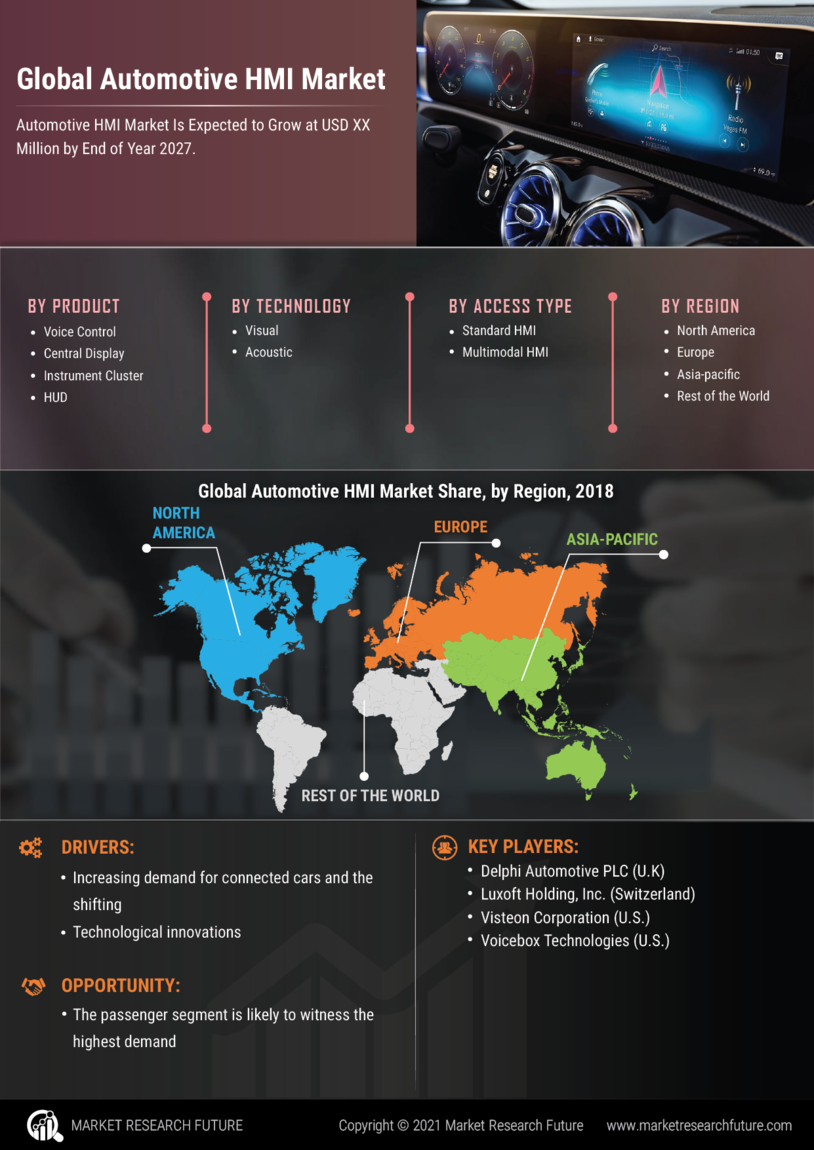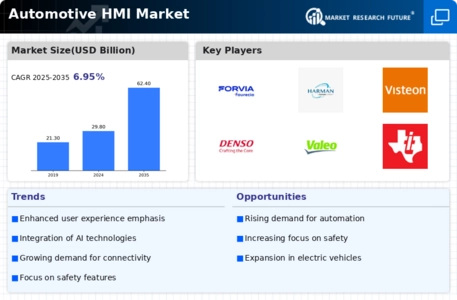Market Growth Projections
The Global Automotive HMI Market Industry is projected to experience substantial growth, with estimates indicating a rise from 29.8 USD Billion in 2024 to 62.4 USD Billion by 2035. This growth trajectory suggests a robust compound annual growth rate (CAGR) of 6.95% from 2025 to 2035. Such projections reflect the increasing integration of advanced technologies in vehicles, driven by consumer demand for enhanced safety, connectivity, and user experience. As automotive manufacturers continue to innovate and adapt to changing consumer preferences, the HMI market is poised for significant expansion in the coming years.
Technological Advancements in HMI
The Global Automotive HMI Market Industry is experiencing rapid technological advancements, particularly in the areas of touchscreens, voice recognition, and augmented reality interfaces. These innovations enhance user experience and safety by allowing drivers to interact with their vehicles more intuitively. For instance, the integration of AI-driven voice assistants enables hands-free control of navigation and entertainment systems, reducing distractions. As a result, the market is projected to reach 29.8 USD Billion in 2024, reflecting a growing demand for sophisticated HMI solutions that prioritize user engagement and safety.
Growing Demand for Electric Vehicles
The shift towards electric vehicles (EVs) is a pivotal driver for the Global Automotive HMI Market Industry. As consumers increasingly opt for EVs, manufacturers are compelled to enhance the HMI systems to provide a seamless driving experience. Features such as real-time battery status, charging station locators, and energy consumption analytics are becoming essential. This trend is expected to contribute significantly to the market's growth, with projections indicating a rise to 62.4 USD Billion by 2035. The integration of advanced HMI in EVs not only improves user satisfaction but also aligns with global sustainability goals.
Increased Focus on User Experience Design
The Global Automotive HMI Market Industry is witnessing an increased focus on user experience design, as manufacturers recognize the importance of intuitive interfaces. A well-designed HMI can significantly enhance driver satisfaction and safety by minimizing distractions and facilitating easier access to critical information. Companies are investing in user-centered design principles, conducting extensive user testing to refine their interfaces. This trend is likely to drive the market forward, as consumers gravitate towards vehicles that offer a superior user experience. The emphasis on design is expected to play a crucial role in shaping the future of automotive HMI.
Regulatory Compliance and Safety Standards
Regulatory compliance and safety standards are crucial factors influencing the Global Automotive HMI Market Industry. Governments worldwide are implementing stringent regulations to enhance vehicle safety and reduce accidents. This has led to the incorporation of advanced HMI features such as driver monitoring systems, which track attention levels and provide alerts when necessary. As a result, automotive manufacturers are investing in HMI technologies that meet these regulations, thereby driving market growth. The emphasis on safety is likely to propel the industry forward, as consumers increasingly prioritize vehicles equipped with advanced safety features.
Consumer Preference for Enhanced Connectivity
Consumer preference for enhanced connectivity is reshaping the Global Automotive HMI Market Industry. Modern drivers expect their vehicles to seamlessly integrate with smartphones and other devices, enabling access to applications, navigation, and entertainment. This demand for connectivity has led to the development of advanced infotainment systems that support smartphone mirroring and cloud-based services. As automotive manufacturers respond to these preferences, the market is anticipated to grow at a CAGR of 6.95% from 2025 to 2035. This growth underscores the importance of connectivity in enhancing the overall driving experience.




















